Written By: Sudeshna Ghosh
Table of Contents
Introduction to Travel Analytic Solutions
The travel industry, along with tourism and hospitality sectors, encounter a distinctive array of challenges and opportunities. As technology advancements continue to reshape global exploration, businesses in these sectors must not only adapt but flourish in an increasingly data-centric milieu. This article delves into the pivotal role of analytics services in reshaping the trajectory of the travel industry, tourism, and hospitality domains, providing a guiding light through the complexities of a contemporary, interconnected world. Analytics is a fundamental tool that can be used to create unforgettable journeys and open up new opinions in a variety of contexts, such as revenue growth optimization, competitive advantage cultivation, marketing strategy creation, and revenue management techniques. Join us on this data-driven expedition towards the future of travel and hospitality.
Book a demo to experience the meaningful insights we derive from data through our travel analytics tools and platform capabilities. Schedule a demo today!
Request a Free DemoQuantzig’s Expertise in Travel Analytic Solutions for a Global Travel Aggregator
| Category | Details |
|---|---|
| Client Details | A global travel aggregator serving both tourism and business travelers across key cities in the US, Europe, and Asia. |
| Challenges Faced by The Client | Data Deficiency, Performance Evaluation, Competing in Diverse Markets, and Launching Value-Based Services. |
| Solutions Offered by Quantzig | Our customer analytics framework mapped customer touchpoints, identified pain points, and highlighted areas for optimization to improve retention by integrating data from multiple sources and analyzing KPIs like CLV, CPA, churn rate, and NPS. |
| Impact Delivered | Reduced the data operations cycle to complete DQM, automated reporting process and workflows, and daily visibility of the business performance. |
Client Details:
The client is a global travel aggregator serving both tourism and business travelers across key cities in the US, Europe, and Asia.
Challenges faced by the Client:
They faced several critical challenges:
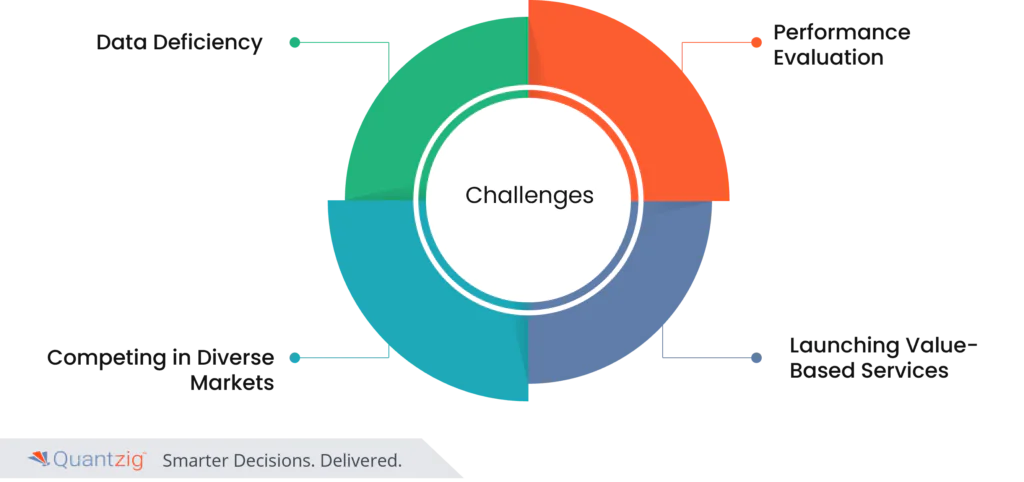
- Data Deficiency: The client lacked a comprehensive and high-quality dataset. Without this foundational data, it was challenging to gain insights into their operations, customer preferences, or market trends. This limited their ability to make informed decisions.
- Performance Evaluation: The absence of a robust data and intelligence layer made it difficult to evaluate the performance of both the supply and demand sides of their business. Without accurate metrics and insights, they couldn’t assess which areas were thriving and which required improvement.
- Competing in Diverse Markets: Operating in diverse markets across continents poses unique challenges. Each region has its own cultural, regulatory, and competitive dynamics. The lack of data and intelligence to understand these nuances hindered their ability to adapt and thrive in these varied environments.
- Launching Value-Based Services: The client’s goal to introduce value-based services required a strong data foundation. These services demand deep insights into customer behavior, pricing strategies, and market trends. Without this, they would struggle to create and market these services effectively.
In essence, the client’s lack of a robust data and intelligence layer was impeding their ability to make data-driven decisions, understand their performance, and succeed in a complex, global, and rapidly evolving industry.
Solutions offered by Quantzig:
Quantzig played a pivotal role in transforming the client’s data operations and reporting processes, enhancing efficiency and enabling faster access to critical insights for product managers and category leaders. By implementing streamlined and automated workflows, they significantly reduced the time it took to deliver data-driven information at a day-to-day level.
Furthermore, our team introduced a boutique analytics solution that was tailored to address specific business needs. This comprehensive solution covered various aspects, including demand sensing, dynamic pricing, customer segmentation, and personalized campaign execution. These capabilities allowed the client to respond dynamically to market fluctuations, optimizing pricing and product offerings based on real-time demand data.
In essence, the collaboration with Quantzig not only improved the speed and accessibility of data but also empowered the client with the tools needed to make data-driven decisions across diverse functions, enhancing their competitiveness and agility in a fast-paced and dynamic market.
Impact Delivered from Quantzig’s Travel Analytic Solutions:
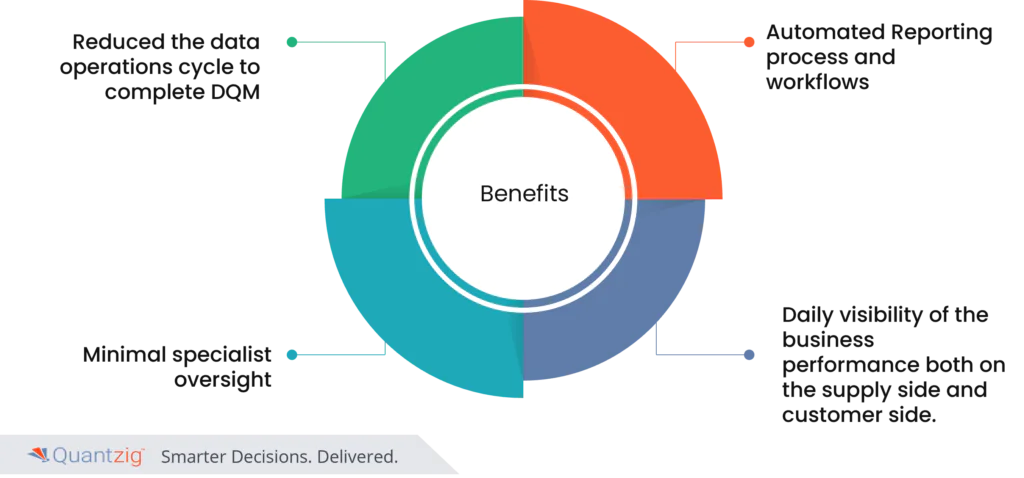
- Reduced the data operations cycle to complete DQM and publishing of reports to 24 hours from the initial rolling 5-day lead time.
- The majority of the reporting process and workflows were fully automated and required minimal specialist oversight.
- The client now has daily visibility of the business performance both on the supply side as well as customer side.
Get started with your complimentary trial today and delve into our platform without any obligations. Explore our wide range of customized, data driven travel analytical solutions built across the analytical maturity levels.
Start your Free TrialImportance of Analytics Services for Tour, Travel & Hospitality Industries
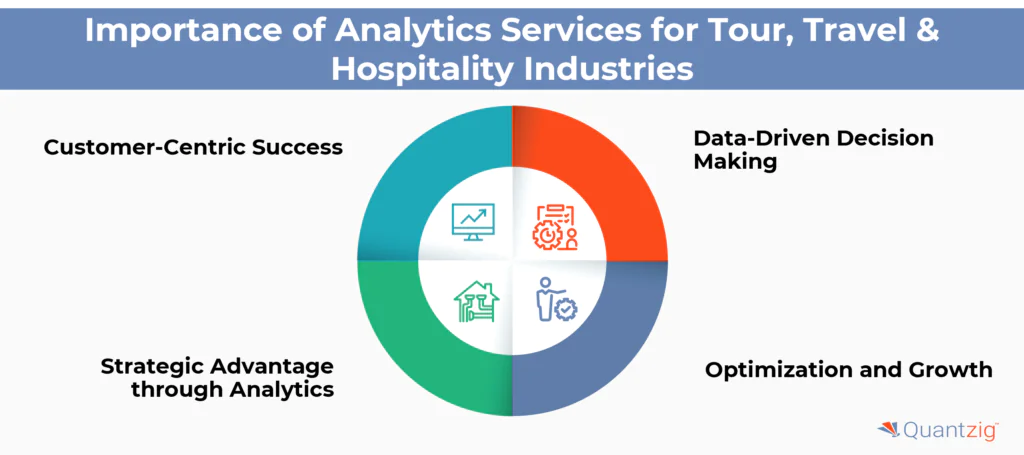
1. Customer-Centric Success
Success within the Travel, Tourism, Hotel, and Logistics (TTHL) industries is intrinsically linked to the pursuit of unparalleled customer centricity and the cultivation of a high repeat customer percentage. In these sectors, customer excellence is not merely a buzzword but a meticulously measured parameter that spans the entire customer lifecycle, shaping each facet of a journey from initial brand engagement to post-trip feedback loops.
2. Data-Driven Decision Making
In the intensely competitive landscape of the Travel Industry within the TTHL industries, those who wield analytics effectively gain a strategic advantage. Analytics isn’t merely a tool; it’s the compass guiding these industries toward sustainable success and enduring customer relationships. Analytics, in this context, stands as the linchpin of this quest for success. It empowers businesses to harness the wealth of data at their disposal to make informed decisions, fine-tune operations, and continuously enhance the customer experience. The ability to glean actionable insights from data influences brand engagement strategies, pricing models, operational efficiency, and personalization efforts.
3. Strategic Advantage through Analytics
Through analytics, companies can predict customer preferences, optimize sales conversions, streamline logistical operations, and, critically, foster Traveler Satisfaction and a Competitive Edge through Experience Personalization. Leveraging Analytical Tools and Data Analytics Techniques, businesses can delve into User Behavioral Metrics and Sentiment Analysis to refine their Marketing Strategies. Incorporating Web Traffic Information aids in understanding market trends, while adopting innovative Travel Technology and Travel Management Software such as TravelPerk Software and Corporate Travel Solutions optimizes operations for their Revenue Management.
4. Optimization and Growth
Additionally, deploying Advanced Travel and Expense Dashboards ensures efficient resource allocation. Ultimately, Travel Analytics serve as the cornerstone of informed decision-making, driving Revenue Growth and sustained success in the dynamic world of travel and hospitality by incorporating Sentiment Analysis, Business travel analytics.
Experience the advantages firsthand by testing a customized complimentary pilot designed to address your specific travel analytics requirements. Pilot studies are non-committal in nature.
Request a Free PilotInternal vs. External Travel Data Sources
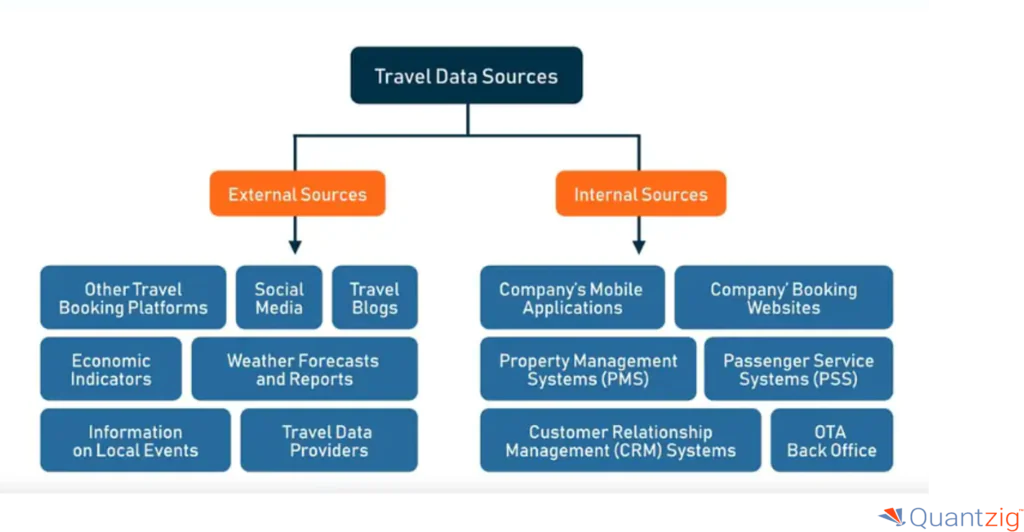
Robust and diverse data from both internal and external sources is a basic requirement for effective travel analytics.
1. Internal travel data sources
The term “internal data” describes the confidential information created and gathered by a company through regular client interactions and business operations. It offers a thorough assessment of a business’s performance, highlighting both its achievements and its room for development.
Travel companies can create customized services that meet the constantly changing needs of their clients by utilizing internal data sources. They can also streamline their operations, improve marketing tactics, and allocate resources more effectively, all of which will contribute to the company’s growth and profitability.
a. Mobile app and booking website
You can monitor and gather a multitude of data using the company’s mobile app and booking website, including user behavioral metrics (such as session duration and navigation paths), geolocation, web traffic data, profiles, and feedback. A travel company’s internal systems are its foundation and the most pertinent source of transaction details, booking histories, and inventory data. Examples of these systems include an airline’s passenger service system (PSS), an OTA back office, or a property management system (PMS) in the hospitality industry.
b. Customer relationship management (CRM) systems
Customer profiles, which include contact details, communication history, travel preferences, age, gender, and location, are part of customer relationship management (CRM) systems. They monitor and record communications between the business and its clients, including phone conversations, emails, and chats. CRM records containing details on membership tiers and rewards accrued may also contain information from loyalty programs.
2. External travel data sources
Datasets and information created outside of an organization and existing beyond its direct ownership, control, or management are collectively referred to as external data. By analyzing external data, travel agencies can maintain their competitiveness, adjust to changing market conditions, and make well-informed decisions about their promotions, pricing, and overall business plans.
a. other travel booking platforms
These are the primary resources for details on what rival companies are offering. You can determine the most popular services, locations, and lodgings by keeping an eye on them and making comparisons. Competitive pricing strategies and inventory optimization are the results of this approach.
b. social media and travel blogs
It has useful details about experiences, suggestions, preferences, and well-liked upcoming events from other travelers. User comments and customer reviews ranging from current trends to destination-specific information can be found on these online platforms.
c. Economic indicators
It includes a broad range of data that shows how an industry, nation, or region is doing economically. They may serve as markers for consumer spending, unemployment, inflation, and exchange rates. This information is crucial to the travel industry’s comprehension of how economic conditions may affect consumer behavior and travel patterns.
d. Travel data providers
They provide lodging facilities, travel companies, and other stakeholders with a wide variety of readily available data. For example, OAG, a well-known authority in this field, has a collection of aviation-related datasets that includes 20 years’ worth of historical flight data. Companies that offer vacation rentals can benefit from AirDNA, Mashvisor, and other data collection services.
Weather reports and forecasts, and details on local events, are additional external data sources useful when developing travel analytics solutions.

4 travel analytics use cases
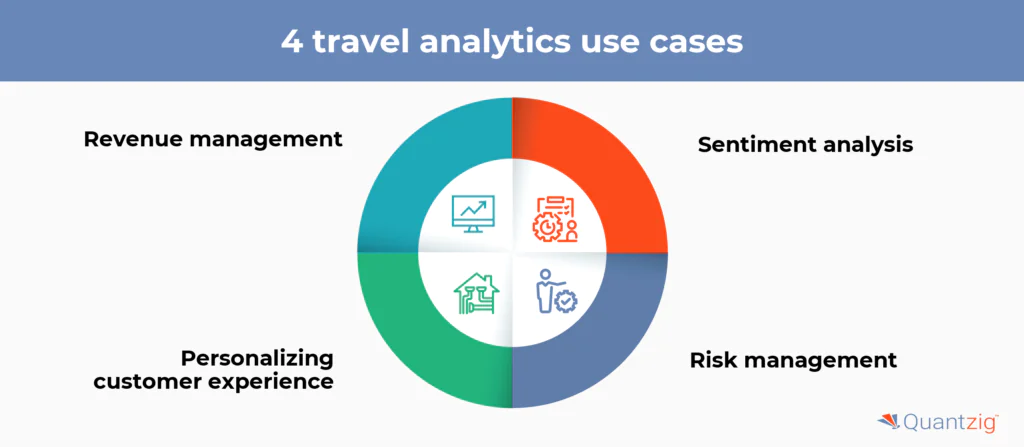
For travel companies, the capacity to use analytical tools on massive amounts of data has changed the game. We’ll examine four important use cases for travel analytics here.
1. Revenue management
Revenue management is used to determine the best prices to charge depending on demand. Finding the ideal balance between prices and existing seat availability, room occupancy levels, etc., requires careful consideration of several factors. That’s where you can benefit from modern analytical techniques.
a. Demand forecasting
Demand forecasting technique with machine learning algorithms allows organizations to identify the slightest shifts in consumer behavior and predict a probable future demand for a product or service. Businesses, for example, can get ready for an increase in business when demand for a particular destination’s flights increases. They can modify costs and design enticing vacation packages.
b. Price prediction
By determining the best prices, price prediction enables businesses to keep a competitive advantage in the marketplace.
c. Occupancy rate prediction
Predicting occupancy rates is essential for data-driven decisions about staff scheduling, planned maintenance, and pricing strategy. Revenue managers can quickly determine periods of increased or decreased interest, such as months in which rooms will be sold at a higher or lower price, by using accurate forecasts.
d. Dynamic pricing
The practice of adjusting a product or service’s price in response to market trends, consumer demand, and other variables is known as dynamic pricing. Revenue managers can optimize profits in constantly shifting conditions by implementing a dynamic pricing strategy that incorporates demand forecasting, price prediction, and occupancy rate prediction.
2. Sentiment analysis
Due to the extensive use of social media, travelers frequently share their insights and advice, giving companies insight into the attitudes and inclinations of their clientele. Sentiment analysis can be performed on this dataset. Sentiment analysis extracts subjective information from text and uses natural language processing (NLP), statistics, and machine learning to interpret emotions, opinions, and judgments. It’s also referred to as opinion mining and classifies feelings as neutral, negative, or positive.
This kind of text analysis can identify problem areas and help with raising customer satisfaction and service quality, which will ultimately improve the brand’s reputation.
3. Personalizing customer experience
More than 70% of consumers anticipate that businesses they interact with will consider their needs and preferences. Through the analysis of variables such as age, interests, values, region, goals, and status, businesses can enable successful personalization strategies for different customer types. Two common examples of how analytics facilitate this process in travel are recommender systems and trip planning tools.
a. Recommender systems
Machine learning algorithms are used by recommended systems to generate personalized offers in real time that are tailored to the needs of a specific traveler. By recommending strategies to lower carbon emissions and lessen overtourism and by recommending locations with fewer visitors, they can also promote sustainable travel.
b. Trip planning
This is another illustration of how analytics influence travel personalization. Seen as a more sophisticated recommender system, it suggests the optimal sequence of destinations to visit based on traveler preferences, behavior, and additional information. Some platforms only offer accommodations or ticket booking; however, more sophisticated services save time and money by providing comprehensive travel arrangements.
4. Risk management
Difficulties in the travel industry can result from a range of unforeseen circumstances. It’s critical to monitor these circumstances and identify any possible disruptions.
a. Fraud detection
Driven by analytics, it assists in identifying minute and obscure occurrences in user behavior that may indicate potential hazards, like fraudulent reservations and chargebacks. In addition to using analytical tools, take steps to prevent travel fraud, such as adding extra verification procedures and making company employees more aware of the possibility of fraud.
b. Guest screening
This is an additional use of travel analytics that involves processing booking information, guest details, and past behavior patterns. Every reservation in this analysis is given a risk score, which is a numerical representation of the possible risk attached to that specific reservation. It considers things like the possibility of property damage, the risk of nonpayment, and the possibility of criminal activity. Hoteliers can use the information gathered from guest screening to make well-informed decisions about accepting reservations. It is possible to establish a safe environment and reduce risks that could affect the property’s reputation, safety, and financial stability by anticipating possible problems before guests arrive.
c. Flight arrival and departure time prediction
It is an effective way to minimize the effects of delays. Airlines and ground handlers can more effectively assign gates, swap out aircraft or crews on specific flights as needed, and reduce tarmac wait times by using machine learning algorithms that take into account a variety of factors, including weather, arrival gates, aircraft type, and more.
d. Predictive maintenance
Machine learning is used in predictive maintenance to analyze data from Internet of Things sensors and identify early indicators of equipment failure. Airlines, automobile rental companies, and other businesses can handle minor issues before they become expensive damages because of this analytical method. Predictive maintenance, for instance, minimizes the need to take an aircraft out of service, aids in scheduling repairs, guards against unforeseen malfunctions, and ensures that flights won’t be delayed.
Conclusion
In the fast-evolving landscape of tourism, Travel, and Hospitality, analytics services emerge as the compass guiding businesses toward a future defined by customer-centric excellence and operational efficiency. The journey through data-driven transformation is not just a choice; it’s a necessity for survival and success. By harnessing the power of analytics, these industries can shape memorable customer experiences, optimize resources, and thrive in an intensely competitive marketplace.



